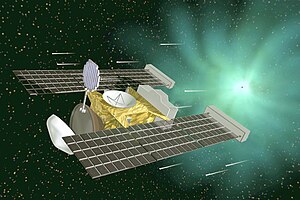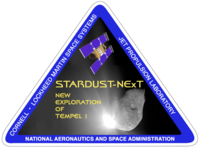Stardust (spacecraft)

Artist's impression of Stardust at comet Wild 2.
|
|
| Mission type | Sample return flyby (81P/Wild) |
|---|---|
| Operator | NASA · JPL |
| COSPAR ID | 1999-003A |
| SATCAT № | 25618 |
| Website | stardust |
| Mission duration | 6 years, 11 months, 8 days |
| Spacecraft properties | |
| Manufacturer | Lockheed Martin · University of Washington |
| Launch mass | 300 kg (660 lb) |
| Power | 330 W (Solar array / NiH2 batteries) |
| Start of mission | |
| Launch date | February 7, 1999 21:04:15 UTC (17 years, 11 months and 30 days ago) |
| Rocket | Delta II 7426 |
| Launch site | Cape Canaveral SLC-17 |
| Contractor | Lockheed Martin Space Systems |
| End of mission | |
| Landing date | January 15, 2006 10:10:00 UTC (11 years and 22 days ago) |
| Landing site |
Utah Test and Training Range 40°21.9′N 113°31.25′W / 40.3650°N 113.52083°W |
| Flyby of 5535 Annefrank | |
| Closest approach | November 2, 2002 04:50:20 UTC (14 years, 3 months and 4 days ago) |
| Distance | 3,079 kilometres (1,913 mi) |
| Flyby of Wild 2 | |
| Closest approach | January 2, 2004 19:21:28 UTC (13 years, 1 month and 4 days ago) |
| Distance | 237 kilometres (147 mi) |
|
|
|

Artist's impression of the Stardust spacecraft performing a burn-to-depletion at the end of the Stardust NExT mission.
|
|
| Mission type | Flyby (9P/Tempel) |
|---|---|
| Operator | NASA · Jet Propulsion Laboratory |
| COSPAR ID | 1999-003A |
| Website | stardustnext |
| Mission duration | 3 years, 8 months, 21 days |
| Start of mission | |
| Entered service | July 3, 2007 (9 years, 7 months and 3 days ago) |
| End of mission | |
| Disposal | Decommissioned |
| Last contact | March 24, 2011 11:33 UTC (5 years, 10 months and 13 days ago) |
| Flyby of Tempel 1 | |
| Closest approach | February 15, 2011 04:42:00 UTC (5 years, 11 months and 22 days ago) |
| Distance | 181 kilometres (112 mi) |
 Official insignia of the Stardust NExT mission |
|

Official insignia of the Stardust mission
Stardust was a 300-kilogram robotic space probe launched by NASA on February 7, 1999. Its primary mission was to collect dust samples from the coma of comet Wild 2, as well as samples of cosmic dust, and return these to Earth for analysis. It was the first sample return mission of its kind. En route to comet Wild 2, the craft also flew by and studied the asteroid 5535 Annefrank. The primary mission was successfully completed on January 15, 2006, when the sample return capsule returned to Earth.
A mission extension codenamed NExT culminated in February 2011 with Stardust intercepting comet Tempel 1, a small Solar System body previously visited by Deep Impact in 2005. Stardust ceased operations in March 2011.
On August 14, 2014, scientists announced the identification of possible interstellar dust particles from the Stardust capsule returned to Earth in 2006.
Beginning in the 1980s, scientists began seeking a dedicated mission to study a comet. During the early 1990s, several missions to study comet Halley became the first successful missions to return close-up data. However, the US cometary mission, Comet Rendezvous Asteroid Flyby, was canceled for budgetary reasons. In the mid-1990s, further support was given to a cheaper, Discovery-class mission that would study comet Wild 2 in 2004.
...
Wikipedia
